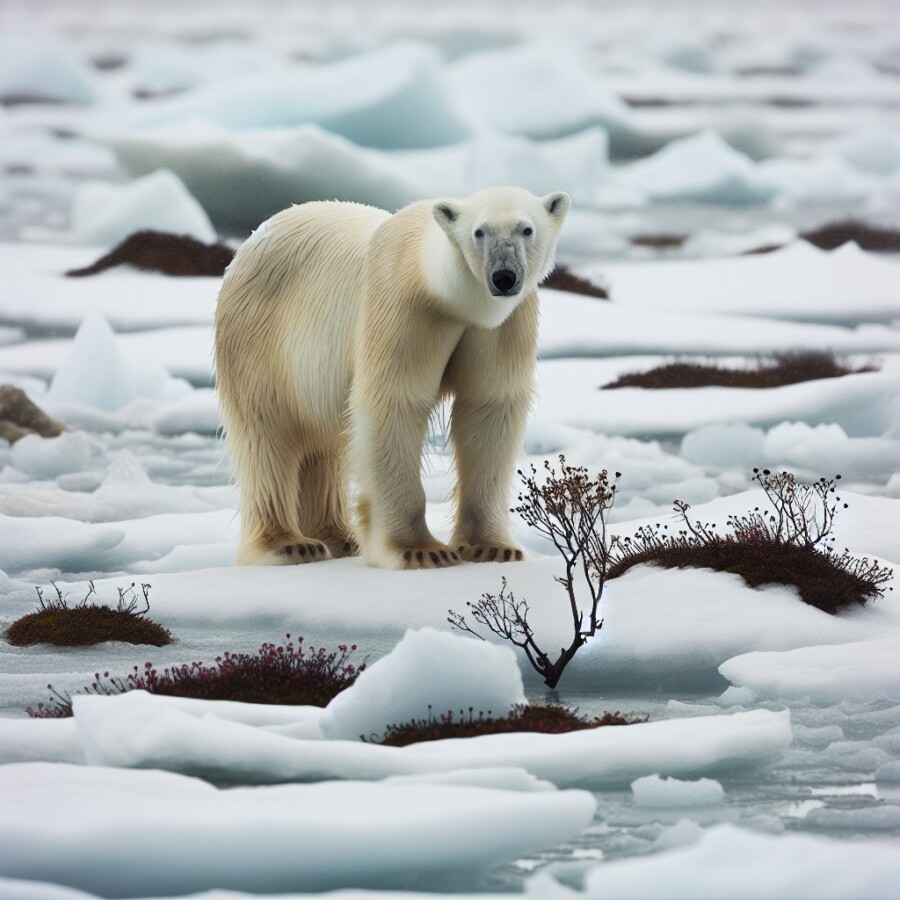Polar bears are facing a threat of starvation as the Arctic sea ice melts, according to scientists. The iconic Arctic species typically feed on ringed seals that they catch on ice floes offshore. However, as the ice disappears due to global warming, many bears are spending more time on land and resorting to eating bird’s eggs, berries, and grass. Unfortunately, these alternative food sources cause the bears to rapidly lose weight, increasing their risk of death. The loss of sea ice is seen as the biggest threat to polar bears, as it is essential for their survival.
A recent study conducted in Western Manitoba found that the ice-free period has increased by three weeks between 1979 and 2015. To understand how polar bears survive as the ice disappears, researchers tracked the activities of 20 bears over a three-year period. The bears were fitted with GPS-equipped video camera collars, allowing scientists to record their movements, activities, and diet. During the ice-free summer months, the bears adopted different strategies to survive, with some conserving energy while others attempted to forage for vegetation or berries. However, all approaches proved unsuccessful, with 19 out of 20 bears losing body mass.
Lead author Dr. Anthony Pagano stated that regardless of the strategy used, there was no real benefit in terms of prolonging the bears’ survival on land. Polar bears are not able to adapt to land-based diets like grizzly bears, making their situation more dire. The study also revealed that two of the three bears that took to the water found carcasses of dead animals but were too tired to eat for an extended period. These findings raise important questions about the species’ ability to adapt to the impacts of climate change.
While the study focused on a specific region, researchers believe that the impacts of climate change on polar bears will vary depending on location. It is likely that polar bears will disappear from areas where sea ice is lost in the future, but it is difficult to predict when and where this will occur. Some areas may still have favorable conditions for bears for many decades to come. However, if sea ice continues to disappear as predicted, conditions in the study area may become very difficult for bears in a short time. The study highlights the urgent need to address climate change and protect the Arctic ecosystem.
Original news source: Polar bears face starvation threat as ice melts (BBC)
🎧 Listen:
Slow
Normal
Fast
📖 Vocabulary:
| 1 | starvation | The state of suffering or dying from not having enough food to eat |
| 2 | iconic | Widely recognized and well-established |
| 3 | floes | Floating sheets of ice |
| 4 | resorting | Turning to a strategy or course of action |
| 5 | alternative | Available as another possibility or choice |
| 6 | essential | Absolutely necessary; extremely important |
| 7 | forage | Search widely for food or provisions |
| 8 | conserving | Keeping or saving something from being used or spent |
| 9 | dire | Extremely serious or urgent |
| 10 | carcasses | Dead bodies of animals |
| 11 | prolonged | Extended in duration; not temporary |
| 12 | adapt | Adjust or become accustomed to a new condition or environment |
| 13 | impacts | Effects or consequences of an action or event |
| 14 | favorable | Advantageous or beneficial in nature |
| 15 | ecosystem | A biological community of interacting organisms and their physical environment |
Group or Classroom Activities
Warm-up Activities:
– News Summary
Instructions: Have students read the article individually or in pairs. Then, ask them to write a concise summary of the article, highlighting the main points. Afterward, invite students to share their summaries with the class and compare them to ensure accuracy and completeness.
– Opinion Poll
Instructions: Divide the class into small groups. Assign each group a specific viewpoint related to the article, such as “Polar bear conservation is a top priority” or “Climate change is a natural phenomenon.” In their groups, students should discuss and gather evidence to support their assigned viewpoint. Then, have each group present their arguments to the class. Finally, conduct a class-wide opinion poll to see which viewpoint gained the most support.
– Vocabulary Pictionary
Instructions: Create a list of key vocabulary words from the article, such as “starvation,” “offshore,” and “conserving.” Divide the class into small teams and provide each team with a set of vocabulary words. One student from each team should come to the front of the class and draw a picture representation of one of the words, while their teammates try to guess the word. The team with the most correct guesses wins.
– Pros and Cons
Instructions: Divide the class into two groups. Assign one group the task of listing the pros of addressing climate change to protect polar bears, while the other group lists the cons. Give students time to brainstorm and discuss their ideas within their groups. Then, bring the class back together for a debate-style discussion, where each group presents their arguments and counters the opposing group’s points.
– Future Predictions
Instructions: Have students work individually or in pairs to think about and write down their predictions for the future of polar bears and their habitat. Encourage them to consider factors such as climate change, human intervention, and conservation efforts. Afterward, students can share their predictions with the class and engage in a discussion about the potential outcomes for polar bears based on their predictions.
🤔 Comprehension Questions:
1. What is the biggest threat to polar bears’ survival?
2. How have polar bears’ feeding habits changed as a result of the melting sea ice?
3. What alternative food sources are polar bears resorting to?
4. Why do these alternative food sources cause polar bears to lose weight?
5. How has the ice-free period changed between 1979 and 2015?
6. How did researchers track the activities of the polar bears in the study?
7. What were the different strategies adopted by the polar bears to survive during the ice-free summer months?
8. What were the findings regarding the bears’ ability to adapt to land-based diets?
Go to answers ⇩
🎧✍️ Listen and Fill in the Gaps:
Polar bears are facing a threat of starvation as the Arctic sea ice melts, according to scientists. The iconic Arctic (1)______ typically feed on (2)______ seals that they catch on ice floes offshore. However, as the ice disappears due to global warming, many bears are spending more time on land and resorting to eating bird’s eggs, berries, and grass. Unfortunately, these alternative food sources cause the bears to rapidly lose (3)______, increasing their risk of death. The loss of sea ice is seen as the biggest threat to (4)______ bears, as it is essential for their survival.
A recent study conducted in Western Manitoba found that the ice-free (5)______ has (6)______ by three weeks between 1979 and 2015. To understand how polar bears survive as the ice (7)______, (8)______ tracked the activities of 20 bears over a three-year period. The bears were fitted with GPS-equipped video camera collars, allowing scientists to record their movements, activities, and diet. During the ice-free summer months, the bears adopted different strategies to survive, with some conserving energy while others attempted to forage for vegetation or berries. However, all approaches proved unsuccessful, with 19 out of 20 (9)______ losing body mass.
Lead author Dr. Anthony Pagano stated that regardless of the strategy used, there was no real benefit in terms of prolonging the bears’ survival on land. Polar bears are not able to adapt to land-based (10)______ like grizzly bears, making their situation more dire. The study also revealed that two of the three bears that took to the water found carcasses of dead (11)______ but were too (12)______ to eat for an extended period. These findings raise important questions about the species’ ability to adapt to the impacts of climate change.
While the study focused on a (13)______ region, researchers believe that the impacts of climate change on polar bears will vary (14)______ on location. It is likely that polar bears will (15)______ from areas where sea ice is lost in the future, but it is (16)______ to predict when and where this will occur. Some areas may still have favorable conditions for bears for many decades to come. However, if sea ice continues to disappear as predicted, conditions in the study area may become very difficult for bears in a short time. The study highlights the urgent need to address climate change and protect the Arctic ecosystem.
Go to answers ⇩
💬 Discussion Questions:
Students can ask a partner these questions, or discuss them as a group.
1. How would you feel if you were a polar bear and your main food source was disappearing?
2. Do you think humans are doing enough to address climate change? Why or why not?
3. What is the biggest threat to polar bears according to the article?
4. How do you think the loss of polar bears would impact the Arctic ecosystem?
5. Do you think it is important to protect endangered species like polar bears? Why or why not?
6. How would you feel if you saw a polar bear in the wild?
7. What do you think can be done to help polar bears survive in a changing climate?
8. Do you think it is fair that polar bears are suffering because of human actions? Why or why not?
9. What is the role of governments and individuals in addressing climate change and protecting polar bears?
10. Have you ever seen a polar bear in a zoo or in the wild? If so, what was your experience like?
11. How do you think the loss of polar bears would impact tourism in the Arctic?
12. What do you think are the long-term consequences of losing polar bears?
13. Do you think it is important for scientists to conduct research on endangered species like polar bears? Why or why not?
14. How do you think the loss of polar bears would impact the global ecosystem?
15. What actions can individuals take to help protect polar bears and address climate change?
Individual Activities
📖💭 Vocabulary Meanings:
Match each word to its meaning.
Words:
1. starvation
2. iconic
3. floes
4. resorting
5. alternative
6. essential
7. forage
8. conserving
9. dire
10. carcasses
11. prolonged
12. adapt
13. impacts
14. favorable
15. ecosystem
Meanings:
(A) Turning to a strategy or course of action
(B) Absolutely necessary; extremely important
(C) Floating sheets of ice
(D) A biological community of interacting organisms and their physical environment
(E) Advantageous or beneficial in nature
(F) Widely recognized and well-established
(G) Dead bodies of animals
(H) Search widely for food or provisions
(I) Available as another possibility or choice
(J) Adjust or become accustomed to a new condition or environment
(K) Keeping or saving something from being used or spent
(L) The state of suffering or dying from not having enough food to eat
(M) Extended in duration; not temporary
(N) Effects or consequences of an action or event
(O) Extremely serious or urgent
Go to answers ⇩
🔡 Multiple Choice Questions:
1. What is the biggest threat to polar bears?
(a) Lack of food
(b) Loss of sea ice
(c) Predators
(d) Disease
2. What do polar bears typically feed on?
(a) Birds
(b) Fish
(c) Ringed seals
(d) Grass
3. How have polar bears been affected by the melting Arctic sea ice?
(a) They are spending more time on land and eating alternative food sources
(b) They are migrating to colder regions
(c) They are adapting to land-based diets
(d) They are hibernating for longer periods
4. What did the recent study in Western Manitoba find?
(a) The ice-free period has increased by three weeks
(b) Polar bears are thriving despite the loss of sea ice
(c) Polar bears are able to adapt to land-based diets
(d) The number of polar bears has significantly decreased
5. How did researchers track the activities of the polar bears in the study?
(a) Satellite imagery
(b) GPS-equipped video camera collars
(c) Footprints in the snow
(d) Observing from a distance
6. What was the outcome for the polar bears in terms of body mass during the ice-free summer months?
(a) All bears gained body mass
(b) All bears maintained their body mass
(c) The study did not provide information on body mass changes
(d) 19 out of 20 bears lost body mass
7. How did the bears in the study attempt to survive during the ice-free summer months?
(a) All bears migrated to colder regions
(b) All bears hibernated for longer periods
(c) Some conserved energy while others foraged for vegetation or berries
(d) All bears relied on alternative food sources like fish
8. What do researchers believe will happen to polar bears in areas where sea ice is lost in the future?
(a) They will adapt to land-based diets like grizzly bears
(b) They will migrate to colder regions
(c) They will thrive despite the loss of sea ice
(d) They will disappear
Go to answers ⇩
🕵️ True or False Questions:
1. Researchers tracked the behaviors of 20 polar bears over a three-year duration using GPS-equipped video camera collars.
2. Two out of three bears that entered the water discovered carcasses of dead animals but were too full to eat for an extended duration.
3. The study highlights the urgent need to address climate change and protect the Arctic ecosystem.
4. Polar bears are not in danger of starvation as the Arctic sea ice melts.
5. A recent study found that the ice-free period has increased by three weeks between 1979 and 2015.
6. All 20 bears lost body mass during the ice-free summer months.
7. Polar bears are unable to adjust to land-based diets like grizzly bears.
8. The loss of sea ice is seen as the biggest threat to polar bears.
Go to answers ⇩
📝 Write a Summary:
Write a summary of this news article in two sentences.
Check your writing now with the best free AI for English writing!
Writing Questions:
Answer the following questions. Write as much as you can for each answer.
Check your answers with our free English writing assistant!
1. What is the biggest threat to polar bears’ survival?
2. How have polar bears’ feeding habits changed as a result of the melting Arctic sea ice?
3. What were the findings of the recent study conducted in Western Manitoba?
4. Why are polar bears unable to adapt to land-based diets like grizzly bears?
5. What are the potential future implications for polar bears if sea ice continues to disappear?
✅ Answers
🤔✅ Comprehension Question Answers:
1. The biggest threat to polar bears’ survival is the loss of sea ice due to global warming.
2. As a result of the melting sea ice, polar bears are spending more time on land and resorting to alternative food sources.
3. Polar bears are resorting to eating bird’s eggs, berries, and grass as alternative food sources.
4. These alternative food sources cause polar bears to rapidly lose weight, increasing their risk of death.
5. The ice-free period has increased by three weeks between 1979 and 2015.
6. Researchers tracked the activities of the polar bears in the study by fitting them with GPS-equipped video camera collars.
7. During the ice-free summer months, the polar bears adopted different strategies to survive, with some conserving energy while others attempted to forage for vegetation or berries.
8. The study found that regardless of the strategy used, there was no real benefit in terms of prolonging the bears’ survival on land. Polar bears are not able to adapt to land-based diets like grizzly bears, making their situation more dire.
Go back to questions ⇧
🎧✍️✅ Listen and Fill in the Gaps Answers:
(1) species
(2) ringed
(3) weight
(4) polar
(5) period
(6) increased
(7) disappears
(8) researchers
(9) bears
(10) diets
(11) animals
(12) tired
(13) specific
(14) depending
(15) disappear
(16) difficult
Go back to questions ⇧
📖💭✅ Vocabulary Meanings Answers:
1. starvation
Answer: (L) The state of suffering or dying from not having enough food to eat
2. iconic
Answer: (F) Widely recognized and well-established
3. floes
Answer: (C) Floating sheets of ice
4. resorting
Answer: (A) Turning to a strategy or course of action
5. alternative
Answer: (I) Available as another possibility or choice
6. essential
Answer: (B) Absolutely necessary; extremely important
7. forage
Answer: (H) Search widely for food or provisions
8. conserving
Answer: (K) Keeping or saving something from being used or spent
9. dire
Answer: (O) Extremely serious or urgent
10. carcasses
Answer: (G) Dead bodies of animals
11. prolonged
Answer: (M) Extended in duration; not temporary
12. adapt
Answer: (J) Adjust or become accustomed to a new condition or environment
13. impacts
Answer: (N) Effects or consequences of an action or event
14. favorable
Answer: (E) Advantageous or beneficial in nature
15. ecosystem
Answer: (D) A biological community of interacting organisms and their physical environment
Go back to questions ⇧
🔡✅ Multiple Choice Answers:
1. What is the biggest threat to polar bears?
Answer: (b) Loss of sea ice
2. What do polar bears typically feed on?
Answer: (c) Ringed seals
3. How have polar bears been affected by the melting Arctic sea ice?
Answer: (a) They are spending more time on land and eating alternative food sources
4. What did the recent study in Western Manitoba find?
Answer: (a) The ice-free period has increased by three weeks
5. How did researchers track the activities of the polar bears in the study?
Answer: (b) GPS-equipped video camera collars
6. What was the outcome for the polar bears in terms of body mass during the ice-free summer months?
Answer: (d) 19 out of 20 bears lost body mass
7. How did the bears in the study attempt to survive during the ice-free summer months?
Answer: (c) Some conserved energy while others foraged for vegetation or berries
8. What do researchers believe will happen to polar bears in areas where sea ice is lost in the future?
Answer: (d) They will disappear
Go back to questions ⇧
🕵️✅ True or False Answers:
1. Researchers tracked the behaviors of 20 polar bears over a three-year duration using GPS-equipped video camera collars. (Answer: False)
2. Two out of three bears that entered the water discovered carcasses of dead animals but were too full to eat for an extended duration. (Answer: False)
3. The study highlights the urgent need to address climate change and protect the Arctic ecosystem. (Answer: True)
4. Polar bears are not in danger of starvation as the Arctic sea ice melts. (Answer: False)
5. A recent study found that the ice-free period has increased by three weeks between 1979 and 2015. (Answer: True)
6. All 20 bears lost body mass during the ice-free summer months. (Answer: True)
7. Polar bears are unable to adjust to land-based diets like grizzly bears. (Answer: False)
8. The loss of sea ice is seen as the biggest threat to polar bears. (Answer: True)
Go back to questions ⇧













